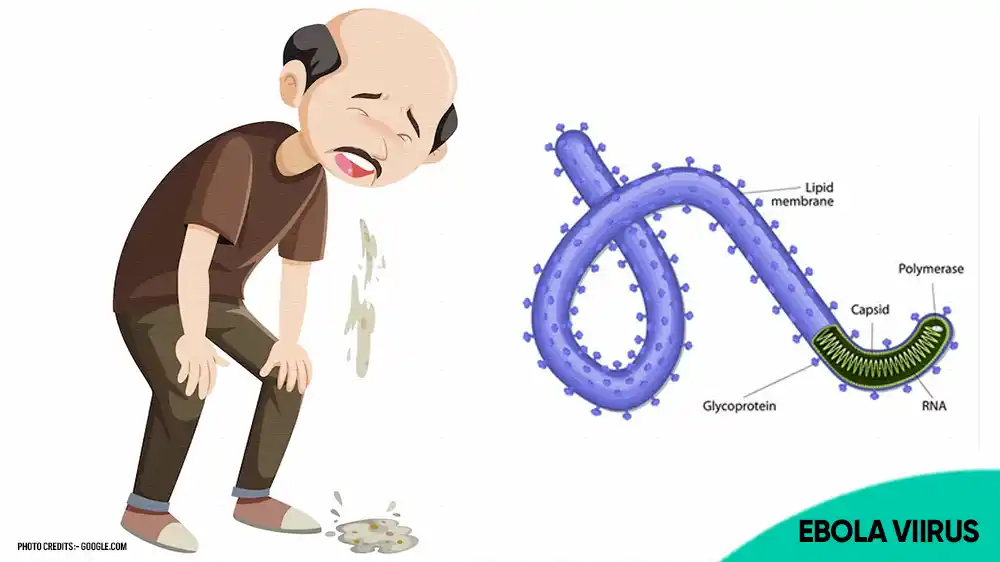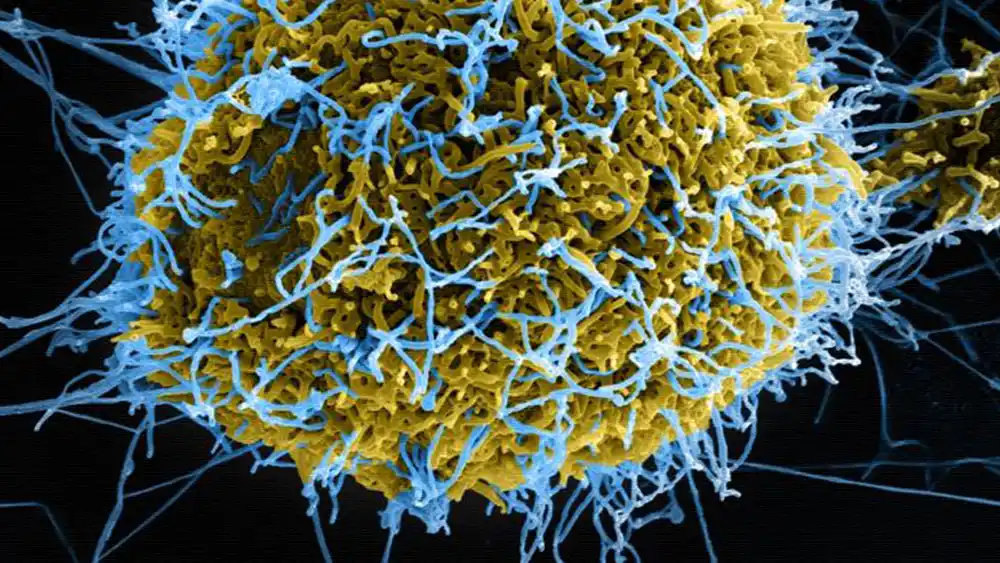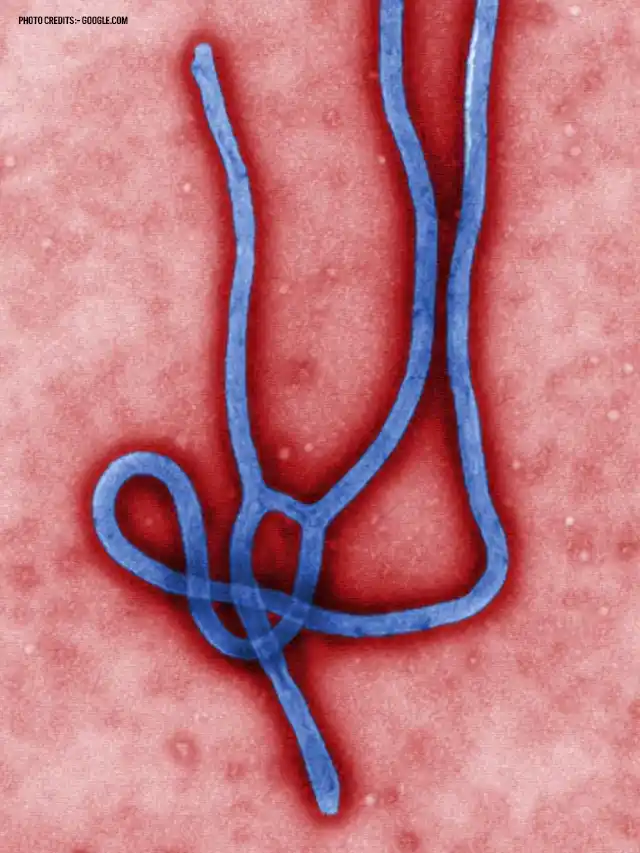
HEALTH BLOG
Ebola Virus Unmasked: Symptoms, Diagnosis, and Recent 2023 Outbreaks
-
 Rahul Priydarss
Rahul Priydarss - May 10, 2024
Ebola Virus: Symptoms, Treatment, and Recent Outbreaks – Explore the latest insights into Ebola virus disease (EVD), including symptoms, diagnosis, treatment options, and recent outbreaks. Learn about the importance of early recognition, supportive care, and ongoing research efforts. Stay informed on how collaboration among healthcare experts and public health authorities is crucial for controlling Ebola outbreaks and protecting global health. Discover key facts and updates on this significant public health challenge.
Introduction of Ebola Virus:
The Ebola virus, a member of the Filoviridae family, is a highly virulent pathogen that causes Ebola virus disease (EVD) in humans and other primates. Identified first in 1976 during outbreaks in Sudan and the Democratic Republic of Congo, the Ebola virus has since garnered global attention due to its severe and often fatal nature. Understanding the characteristics and behavior of the Ebola virus is crucial for effectively preventing, containing, and treating EVD. This introduction sets the stage for exploring the origins, transmission, symptoms, diagnosis, treatment, and preventive measures associated with Ebola.
What is Ebola Virus:
Ebola virus, also known as Ebola virus disease (EVD) or Ebola hemorrhagic fever (EHF), is a group of viruses that cause severe illness. Fruit bats are the natural carriers of this virus. Humans can become infected through contact with infected animals (dead or alive) or their bodily fluids. The virus can also spread from person to person through direct contact with bodily fluids (blood, saliva, vomit, feces) of someone who is sick or has recently died from Ebola.
Early symptoms of Ebola are flu-like and include fever, fatigue, and muscle pain. As the disease progresses, it can lead to vomiting, diarrhea, rash, and internal and external bleeding. Ebola can be fatal, with an average mortality rate of around 50%. Some strains can be even more deadly.

Table of Contents
Brief overview of the Ebola virus:
The Ebola virus is a highly infectious pathogen in the family Filoviridae. It is responsible for causing Ebola virus disease (EVD), a severe illness with high mortality rates in humans and non-human primates. The virus was first identified in 1976 during outbreaks in Sudan and the Democratic Republic of Congo, with subsequent sporadic outbreaks occurring primarily in Central and West Africa. The Ebola virus is notorious for its rapid onset of symptoms, which can include fever, severe headache, muscle pain, weakness, vomiting, diarrhea, and in some cases, internal and external bleeding. The virus is transmitted through direct contact with the bodily fluids of infected individuals or animals, and outbreaks often occur in communities with limited healthcare resources. Prevention and control measures focus on infection control practices, early detection, isolation of cases, contact tracing, and vaccination efforts. Despite ongoing research and intervention efforts, the Ebola virus remains a significant public health threat, underscoring the importance of continued vigilance and preparedness in managing outbreaks.
Importance of understanding its symptoms:
Understanding the symptoms of Ebola virus disease (EVD) is of utmost importance for several reasons.
Firstly, early recognition of Ebola symptoms allows for prompt diagnosis and treatment. Ebola virus infection can progress rapidly, and early medical intervention can significantly improve patient outcomes and increase the chances of survival. Therefore, knowing the hallmark symptoms such as fever, headache, muscle pain, and vomiting can prompt individuals to seek medical attention promptly, leading to timely intervention and supportive care.
Secondly, understanding the symptoms helps in containing the spread of the virus. Ebola is highly contagious, and transmission occurs through direct contact with the bodily fluids of infected individuals. By recognizing the symptoms early, infected individuals can be isolated, and appropriate infection control measures can be implemented to prevent further spread within communities and healthcare settings.
Moreover, awareness of Ebola symptoms is essential for healthcare workers and public health authorities. Healthcare providers need to be able to recognize potential cases of Ebola quickly to implement appropriate infection control measures and prevent healthcare-associated transmission. Public health authorities rely on surveillance systems that detect clusters of symptoms consistent with Ebola to initiate outbreak response activities, including contact tracing and vaccination campaigns.
Additionally, understanding the symptoms of the Ebola virus helps dispel misinformation and stigma associated with the disease. By educating communities about the signs and symptoms of EVD, individuals are empowered to take appropriate precautions to protect themselves and their loved ones. Moreover, accurate information about Ebola symptoms can help reduce fear and discrimination against those affected by the disease.
Origin and discovery of Ebola Virus:
The story of Ebola starts in 1976 with its dramatic discovery. Two outbreaks of a mysterious and deadly hemorrhagic fever occurred almost simultaneously in different parts of Central Africa.
- The first outbreak emerged in a village near the Ebola River in what is now the Democratic Republic of Congo. The river’s name would later lend itself to the newly discovered virus.
- Another outbreak occurred around 500 miles away in what is now South Sudan. Initially, public health officials thought these might be connected, perhaps due to an infected person traveling between the two locations.
These outbreaks marked the first time Ebolaviruses were identified. Since then, scientists haven’t pinpointed a specific origin for the virus, but they believe fruit bats are likely the natural reservoir hosts. The exact route of transmission from bats to humans remains under investigation.
Ebola Virus Year in 2024:
The year is 2024. The Kenyan sun beats down on Nairobi, a vibrant city alive with the energy of its diverse population. Modern skyscrapers pierce the sky, casting long shadows over bustling marketplaces overflowing with colourful fabrics and fresh produce. Delivery drones whiz overhead, weaving through the network of sleek, self-driving vehicles gliding down the streets.
However, a sense of unease hangs in the air. News reports flash on holographic displays scattered throughout the city, detailing a recent suspected case of Ebola in a neighboring country. People move more cautiously, some wearing protective masks despite the sweltering heat. Health clinics are on high alert, with medical personnel running drills and refreshing protocols for handling potential Ebola cases.
In a bustling tech hub, a team of researchers hunches over computer screens, analyzing genetic sequences. They’re part of a global network rapidly working to identify the specific strain of Ebola and develop targeted treatments. Collaboration is key, with scientists sharing data and expertise virtually across continents.
Meanwhile, in a quiet neighborhood, a young woman named Abeni watches the news with a furrowed brow. Her grandmother, who lives in a remote village, has been experiencing flu-like symptoms. Abeni knows that early detection is crucial, so she uses her smartphone to book a virtual consultation with a doctor, hoping to rule out Ebola as a possibility.
Despite the tension, there’s a quiet determination in the air. Nairobi, a city accustomed to facing challenges, is prepared to act swiftly if necessary. The experience with past outbreaks has instilled a sense of vigilance, and the city’s advanced infrastructure allows for rapid communication and coordination.
Classification and characteristics of Ebola virus:
The Ebola virus belongs to the family Filoviridae and the genus Ebolavirus. There are five species of Ebola virus identified so far.
- Zaire ebolavirus (EBOV)
- Sudan ebolavirus (SUDV)
- Bundibugyo ebolavirus (BDBV)
- Tai Forest ebolavirus (TAFV)
- Reston ebolavirus (RESTV)
Among these, Zaire ebolavirus (EBOV) is the most virulent and has caused the majority of Ebola virus disease (EVD) outbreaks in humans. Sudan ebolavirus (SUDV) and Bundibugyo ebolavirus (BDBV) have also been responsible for outbreaks of EVD in Africa. The Ebola virus is characterized by several unique features.
Filamentous Structure: Ebola virus particles are filamentous in shape, appearing as long, thin, and sometimes branched structures under electron microscopy.
Envelope: The virus is enveloped, meaning it is surrounded by a lipid membrane derived from the host cell’s plasma membrane. This envelope contains glycoproteins that are essential for viral entry into host cells.
Single-stranded RNA Genome: The genome of Ebola virus consists of a single strand of RNA, which encodes the viral proteins necessary for replication and assembly.
Negative-sense RNA: The RNA genome of Ebola virus is negative-sense, meaning it cannot be directly translated into proteins by host ribosomes. Instead, it must first be transcribed into complementary positive-sense RNA before protein synthesis can occur.
Virulence Factors: Ebola virus encodes several virulence factors that contribute to its pathogenicity, including proteins that interfere with host immune responses and promote viral replication.
High Pathogenicity: Ebola virus is highly pathogenic in humans, causing severe illness with high mortality rates. The virus targets multiple organs and tissues, leading to systemic manifestations such as hemorrhage, organ failure, and shock.
Transmission of Ebola Virus:
The transmission of Ebola virus occurs through direct contact with bodily fluids of infected individuals or animals. Here are some key points regarding the transmission of Ebola virus.
Human-to-Human Transmission: The primary mode of Ebola virus transmission is through direct contact with the blood, saliva, vomit, urine, feces, or other bodily fluids of infected individuals. This can occur through broken skin or mucous membranes, such as those in the eyes, nose, or mouth.
Close Contact: Close and prolonged contact with infected individuals, particularly during caregiving, funeral rites, or medical procedures, increases the risk of transmission. Healthcare workers are at high risk due to their proximity to patients and exposure to bodily fluids.
Nosocomial Transmission: Ebola virus can spread within healthcare settings if appropriate infection control measures are not followed. Contaminated medical equipment, needles, and surfaces can serve as vehicles for transmission.
Sexual Transmission: Ebola virus can persist in semen for several months after recovery from the illness. Sexual transmission of the virus has been documented, and individuals are advised to practice safe sex or abstain from sexual activity during this period.
Animal-to-Human Transmission: Ebola virus is believed to originate from fruit bats, which serve as natural reservoirs for the virus. Human infection can occur through direct contact with infected animals, such as bats, primates, or other mammals hunted for food.
Rare Modes of Transmission: While less common, Ebola virus can also be transmitted through other routes, such as exposure to contaminated objects or surfaces, or through aerosol transmission in laboratory settings.
Preventing transmission of Ebola virus requires strict adherence to infection control practices, including.
Hand Hygiene: Regular handwashing with soap and water or use of alcohol-based hand sanitizers.
Personal Protective Equipment (PPE): Healthcare workers should use appropriate PPE, including gloves, gowns, masks, and goggles, when caring for patients with suspected or confirmed Ebola virus infection.
Safe Burial Practices: Proper handling and burial of deceased individuals to prevent exposure to bodily fluids.
Isolation and Quarantine: Prompt identification and isolation of suspected cases, along with contact tracing and quarantine of individuals who may have been exposed.

Symptoms of Ebola Virus:
Ebola virus disease (EVD) manifests with a range of symptoms, which can vary in presentation and severity among individuals. Understanding the progression of symptoms is essential for early detection and treatment. The symptoms of Ebola virus can be categorized into early symptoms, advanced symptoms, and variability in symptom presentation.
Early Symptoms:
Fever: One of the initial signs of Ebola virus infection is the sudden onset of fever. This fever is often abrupt and accompanied by chills or shivering.
Headache: Severe headaches are common early symptoms of EVD. Individuals may experience intense and persistent headaches, which can be debilitating.
Muscle Pain: Ebola virus infection can cause muscle pain and joint pain throughout the body. This muscle pain is often severe and contributes to overall weakness and discomfort.
Fatigue: Profound weakness and fatigue may set in early during EVD. Individuals may feel extremely tired and lethargic, with a lack of energy to perform daily activities.
Sore Throat: Some individuals infected with Ebola virus may experience a sore throat, along with difficulty swallowing or discomfort in the throat area.
Advanced Symptoms:
Vomiting: Nausea and vomiting are common symptoms of advanced EVD. Vomiting may be severe and frequent, leading to dehydration and electrolyte imbalances.
Diarrhea: Severe, watery diarrhea is another hallmark symptom of advanced EVD. Diarrhea can be persistent and debilitating, further contributing to dehydration and weakness.
Rash: A maculopapular rash may develop in some individuals with advanced EVD. This rash typically appears 5 to 7 days after the onset of symptoms and may be itchy or uncomfortable.
Internal and External Bleeding: In severe cases of EVD, individuals may experience internal and external bleeding. This can manifest as bleeding from the gums, nose, or other mucous membranes, as well as internal bleeding in the gastrointestinal tract or other organs.
Impaired Organ Function: Ebola virus infection can lead to impaired kidney and liver function, as well as other organ dysfunction. Abnormalities in blood tests may indicate organ damage and contribute to the overall deterioration of health.
Diagnosing of Ebola virus:
Diagnosing Ebola virus disease (EVD) involves a combination of clinical evaluation, laboratory testing, and epidemiological investigation. Given the severity and potential for outbreaks, prompt and accurate diagnosis is critical for initiating appropriate treatment and implementing public health measures to prevent further transmission. Here are the key aspects of diagnosing Ebola virus.
Clinical Evaluation: Healthcare providers assess individuals for symptoms consistent with EVD, including fever, headache, muscle pain, weakness, vomiting, diarrhea, and bleeding. A thorough medical history, including recent travel to areas with known Ebola outbreaks or contact with infected individuals, is essential.
Laboratory Testing: Laboratory confirmation of Ebola virus infection is achieved through various diagnostic tests, including:
- Polymerase Chain Reaction (PCR): PCR tests detect the presence of Ebola virus genetic material (RNA) in blood, serum, or other bodily fluids. This test is highly sensitive and specific and is considered the gold standard for Ebola diagnosis.
- Antigen Detection Tests: Rapid antigen detection tests are available for diagnosing Ebola virus infection in certain settings. These tests detect viral proteins in blood or serum and provide results within a few hours.
- Serological Tests: Serological tests detect antibodies against Ebola virus in blood samples. While useful for confirming past infection or immune response, they are less reliable for diagnosing acute cases of EVD.
Sample Collection: Specimens for laboratory testing include blood, serum, saliva, urine, and other bodily fluids. Samples must be collected and handled with strict infection control measures to prevent exposure to healthcare workers and laboratory personnel.
Epidemiological Investigation: Public health authorities conduct thorough epidemiological investigations to identify potential sources of infection, trace contacts of confirmed cases, and implement control measures to contain outbreaks. This involves interviewing patients to determine their travel history, contact with infected individuals, and potential exposure to Ebola virus.
Differential Diagnosis: Healthcare providers must consider other infectious diseases with similar symptoms when evaluating patients for EVD. These may include malaria, typhoid fever, influenza, and other viral hemorrhagic fevers. Laboratory testing and clinical judgment help differentiate Ebola virus from other illnesses.
Point-of-Care Testing: In outbreak settings or resource-limited areas, point-of-care diagnostic tests may be used to quickly diagnose EVD and facilitate early intervention. These tests are often portable, easy to use, and provide rapid results, aiding in timely patient management and outbreak control.
Treatment of Ebola Virus:
Treatment of Ebola virus disease (EVD) primarily involves supportive care to manage symptoms, prevent complications, and improve patient outcomes. While there is no specific antiviral medication approved for treating Ebola virus, early medical intervention and supportive measures can significantly increase the chances of survival. Here are the key aspects of treating Ebola virus.
Fluid and Electrolyte Management: Dehydration is common in individuals with EVD due to symptoms such as vomiting and diarrhea. Intravenous fluids are administered to maintain hydration and electrolyte balance. Close monitoring of fluid status and electrolyte levels is essential to prevent complications such as electrolyte imbalances and shock.
Symptomatic Treatment: Medications are prescribed to alleviate symptoms such as fever, headache, muscle pain, and nausea. Antipyretic drugs may be used to reduce fever, while analgesics can help alleviate pain and discomfort. Antiemetic drugs may be given to control nausea and vomiting.
Nutritional Support: Adequate nutrition is crucial for supporting the body’s immune response and promoting recovery. Nutritional supplements or enteral feeding may be provided to individuals unable to eat or maintain adequate oral intake due to severe illness.
Experimental Therapies: Several experimental treatments have been investigated for the treatment of Ebola virus, including antiviral drugs, monoclonal antibodies, and convalescent plasma therapy. While some of these treatments have shown promise in preclinical studies or early clinical trials, their efficacy and safety in treating EVD require further evaluation.
Isolation and Infection Control: Patients with suspected or confirmed EVD are isolated to prevent transmission of the virus to others. Strict infection control measures are implemented to minimize the risk of healthcare-associated transmission, including the use of personal protective equipment by healthcare workers, proper disinfection of surfaces and equipment, and safe handling and disposal of contaminated materials.
Psychosocial Support: Individuals affected by EVD may experience psychological distress due to fear, stigma, and uncertainty about their condition. Psychosocial support services, including counseling and mental health interventions, are provided to address emotional and social needs and promote well-being during and after illness.
Monitoring and Surveillance: Patients with EVD require close monitoring of vital signs, clinical status, and laboratory parameters. Regular assessments help identify complications, monitor disease progression, and guide treatment decisions. Surveillance systems are also established to monitor the spread of Ebola virus within communities and detect outbreaks early.
Post-Recovery Care: Individuals who survive EVD may experience lingering symptoms or complications, such as fatigue, weakness, and musculoskeletal pain. Post-recovery care and follow-up evaluations are provided to address ongoing health issues and support rehabilitation and recovery.
Medicine for Ebola Virus:
As of the latest information available, there is no specific antiviral medication approved for the treatment of Ebola virus disease (EVD). However, several experimental treatments have been investigated in clinical trials and preclinical studies to identify effective therapies for EVD. Some of these experimental treatments include.
Antiviral Drugs: Various antiviral drugs have been evaluated for their potential efficacy against Ebola virus. These drugs target different stages of the viral replication cycle, such as viral entry, replication, or assembly. While some antiviral drugs have shown promise in laboratory studies or animal models, their effectiveness in humans requires further evaluation in clinical trials.
Monoclonal Antibodies: Monoclonal antibodies are laboratory-produced proteins that mimic the immune system’s ability to fight off pathogens, including viruses. Several monoclonal antibodies targeting Ebola virus proteins have been developed and tested in clinical trials. These antibodies may help neutralize the virus and reduce disease severity in infected individuals.
Convalescent Plasma Therapy: Convalescent plasma therapy involves transfusing plasma obtained from individuals who have recovered from EVD into patients with active infection. The plasma contains antibodies against Ebola virus, which may help boost the patient’s immune response and aid in viral clearance. While preliminary studies have shown some benefit of convalescent plasma therapy in treating EVD, further research is needed to establish its efficacy and safety.
Viral Entry Inhibitors: Drugs that target the entry of Ebola virus into host cells are being investigated as potential treatments for EVD. These drugs may block viral attachment or fusion with host cell membranes, thereby preventing viral entry and replication. Early studies have shown promising results with certain viral entry inhibitors, but their clinical efficacy remains to be established.
Immunomodulatory Agents: Immunomodulatory agents, such as interferons and other immune modulators, are being explored for their potential to modulate the host immune response to Ebola virus infection. These agents may help regulate the inflammatory response, enhance antiviral immunity, and improve clinical outcomes in patients with EVD.
New drug research for Ebola virus:
Absolutely! Here’s what we know as of today, May 10th, 2024, regarding new drug research for Ebola virus.
Oral Antiviral Shows Promise: A significant development in March 2024 was the publication of research on an oral antiviral drug called Obeldesivir. This study, conducted on non-human primates, showed promising results in protecting against the Sudan ebolavirus, a strain closely related to Zaire ebolavirus. Obeldesivir is already being investigated for treating Marburg virus, another filovirus. If successful in further trials, an easily administered oral medication could be a game-changer in managing Ebola outbreaks, especially in remote areas.
Targeting the Replication Process: Another area of active research involves identifying and targeting specific steps in the Ebola virus’s replication process. By disrupting how the virus makes copies of itself within infected cells, scientists hope to hinder its ability to spread and cause disease. Several potential drug candidates are currently under investigation based on this approach.
Broad-Spectrum Treatments: As mentioned earlier, current monoclonal antibody therapies are effective against specific strains. Researchers are actively developing drugs with a broader spectrum of activity, meaning they would be effective against multiple Ebolavirus species. This would be crucial for preparedness in case of outbreaks caused by less common strains.
Combination Therapies: Exploring the potential benefits of combining existing treatments with new drugs is another area of active research. This multi-pronged approach could potentially improve treatment efficacy and patient outcomes.
Recent Outbreaks of Ebola virus:
Thankfully, there haven’t been any reported outbreaks of Ebola virus since the one declared over in Uganda on January 11th, 2023. This outbreak, caused by the Sudan ebolavirus strain, resulted in 164 confirmed cases and 77 deaths.
However, it’s crucial to stay vigilant. Here’s a quick look at some recent outbreaks to understand the ongoing threat:
Uganda (September 2022 – January 2023): This outbreak, caused by the Sudan ebola virus, was the most recent one. The swift response by Ugandan health authorities and the availability of a vaccine for this strain helped control the situation.
Democratic Republic of the Congo (August 2022): A brief outbreak of Ebola virus disease was contained in North Kivu province. The specific strain involved wasn’t publicly reported.
FAQs about Ebola Virus:
A1: Survival rates vary depending on factors such as prompt treatment and overall health status. However, mortality rates can be high, especially in severe cases.
A2: No, Ebola is not transmitted through the air. It requires direct contact with the bodily fluids of infected individuals for transmission.
A3: Symptoms typically appear 2 to 21 days after exposure to the virus, with an average incubation period of 8 to 10 days.
A4: There is no specific cure for Ebola, but supportive care and experimental treatments can improve outcomes.
A5: Practicing good hygiene, avoiding contact with infected individuals or their bodily fluids, and participating in vaccination efforts are essential for protecting oneself from Ebola virus disease.

-Please remember, to always consult with healthcare professionals or Doctors for personalised advice related to medical conditions.
Conclusion:
Understanding Ebola virus disease (EVD) is crucial for effective prevention and treatment. Early recognition of symptoms, prompt diagnosis, and supportive care are essential for improving patient outcomes. While there is no specific cure, ongoing research into new treatments offers hope for better management of EVD. Recent outbreaks highlight the persistent threat posed by Ebola virus, underscoring the need for continued vigilance and preparedness. Collaboration among healthcare providers, researchers, and public health authorities is essential for controlling outbreaks and safeguarding public health. Despite challenges, concerted efforts to address EVD are vital for mitigating its impact on affected communities.




